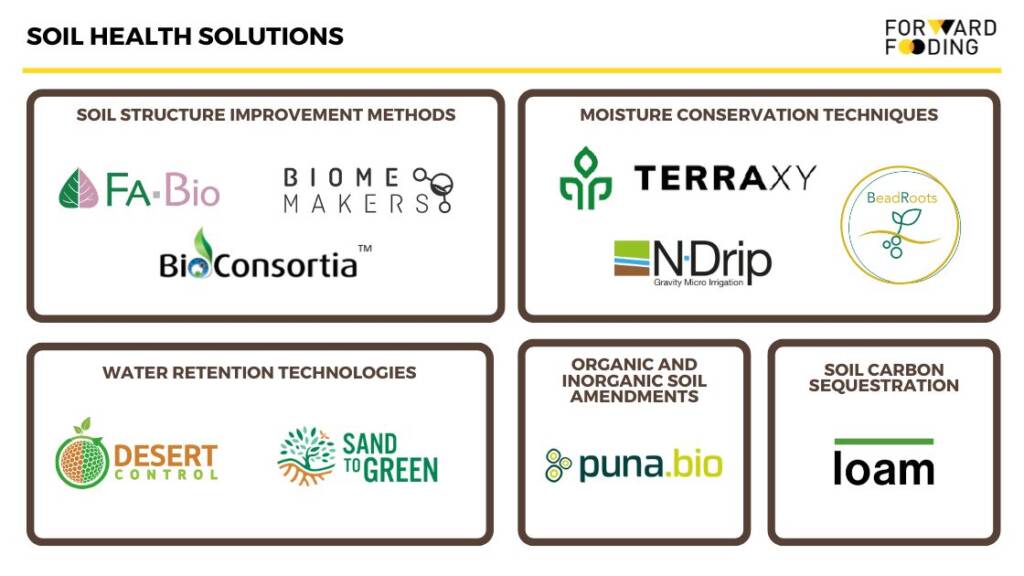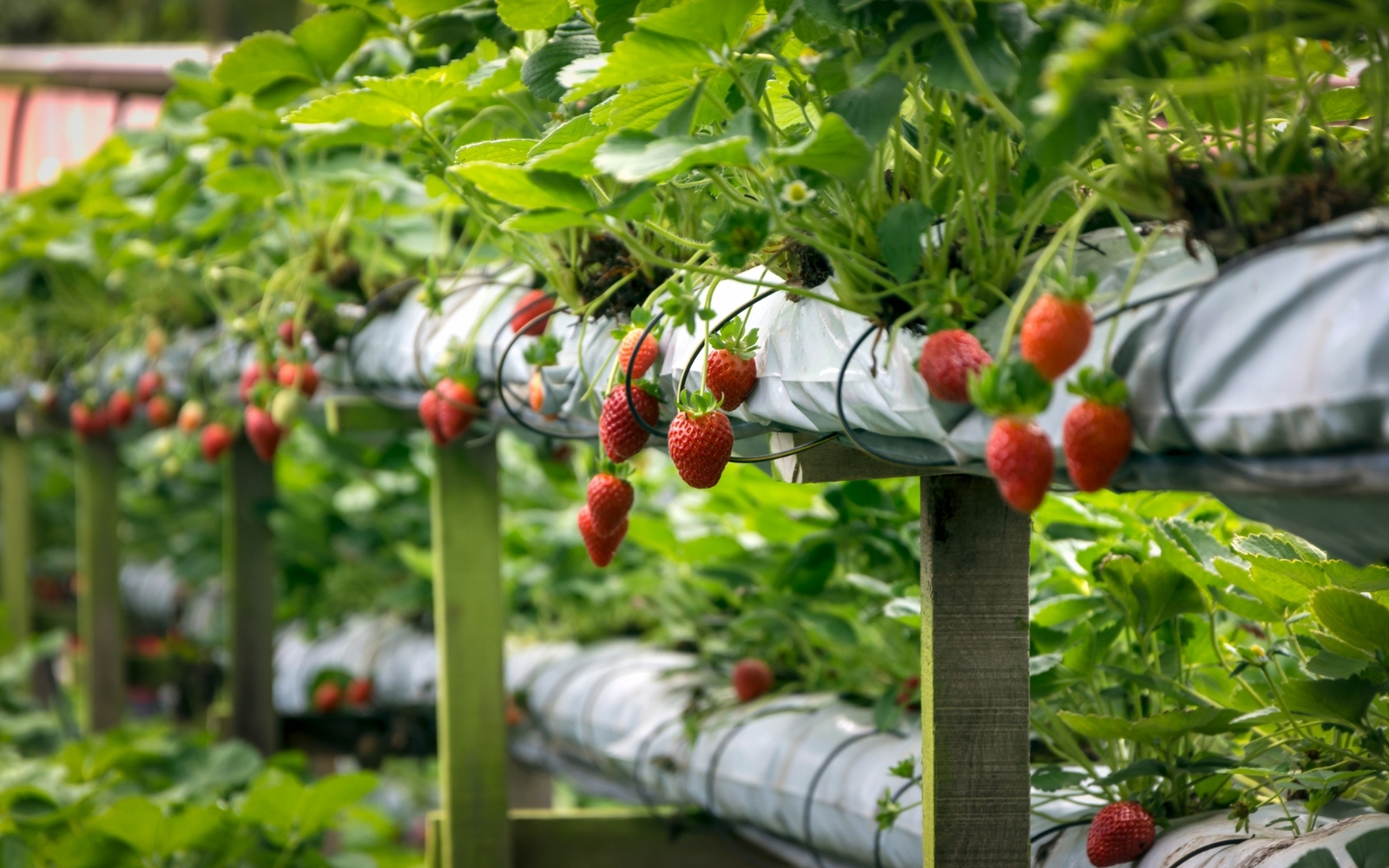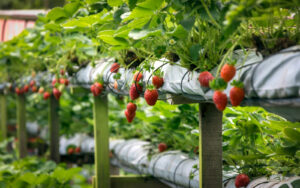Building Agricultural Resilience Through Innovative Soil Health Solutions
Soil degradation poses a significant challenge to ecosystems and global food security. Fragile soils in desert and water-scarce environments are particularly vulnerable to the combined pressures of human activity and climate change, which can threaten agricultural productivity and biodiversity.
According to the FAO, approximately 33% of the world’s soils are moderately to severely degraded, and many of these are found in regions burdened by poverty and food insecurity. This stark overlap underscores the critical link between soil health and food security, highlighting an urgent need for action.
In the third installment of our Water Tech series, we examine startups that leverage innovative technologies to optimize soil health and how their solutions support sustainable agriculture in areas most affected by water scarcity and land degradation. These companies combine advanced irrigation methods with data analytics to boost water efficiency and improve soil structure. This integration of water management and soil optimization is vital for building resilience in agricultural systems, empowering farmers to succeed in the face of climate change and resource limitations.
The Roots of Soil Health Challenges
Soil degradation refers to the deterioration of soil quality, leading to a reduction in its capacity to produce food, support ecosystems, and provide essential services. This process can occur due to various natural and human-induced factors, including erosion, nutrient depletion, salinization, and pollution. Specifically, soil degradation manifests through a decline in the biological and economic productivity of the land.
The consequences of soil degradation are profound, affecting not only agricultural output but also the overall health of ecosystems and the livelihoods of communities dependent on these lands.
In arid regions, there are three critical issues concerning soil health: water retention, nutrient deficiency, and soil structure.
Water Retention
Water retention is a significant challenge in arid environments where high evaporation rates and limited rainfall hinder the soil’s ability to retain moisture. Soils in these regions often have low organic matter content, which is essential for improving water-holding capacity. Consequently, crops may suffer from drought stress even during periods of limited rainfall.
Nutrient Deficiency
Nutrient deficiency is another pressing issue in arid soils. These soils frequently lack essential nutrients due to leaching from rainfall or erosion caused by wind and water. The depletion of vital nutrients like nitrogen, phosphorus, and potassium can severely impact plant growth and agricultural productivity. Additionally, the use of chemical fertilizers without proper management can lead to further degradation of soil health by disrupting microbial activity and diminishing organic matter content.
Soil Structure
The structure of arid soils is often compromised due to factors such as compaction from heavy machinery or overgrazing by livestock. Poor soil structure can lead to decreased aeration and infiltration rates, making it difficult for roots to access water and nutrients. This compaction can also exacerbate erosion problems by reducing the soil’s ability to absorb rainfall effectively.
Implementing effective management strategies can help mitigate the impacts of degradation and promote sustainable agricultural practices that enhance productivity while preserving the environment.
Breaking Ground: Enablers of Soil Optimization Innovations
Several key drivers are facilitating the development of soil optimization technologies, reflecting the urgent need to address the challenges posed by soil degradation.
One of the primary drivers is climate change. As climate change intensifies, farmers start to adopt strategies such as drought-tolerant crops, diversified planting, and efficient irrigation systems to build resilience against unpredictable weather patterns. These practices not only mitigate climate risks but also improve food security by ensuring steady agricultural productivity.
Technological advancements also play a pivotal role. Precision agriculture tools leverage data to optimize resource use, while innovations like biochar application and organic soil amendments restore soil fertility and enhance moisture retention. These solutions reduce waste and environmental harm, fostering sustainable agricultural practices.
Additionally, growing concerns over global food security, fueled by population growth, drive the demand for sustainable practices that maximize yields without depleting natural resources. Governments and private organizations are channeling investments into research and development, scaling innovative soil health solutions, and making them accessible to farmers globally.
Together, these drivers highlight a multifaceted approach to addressing soil degradation through technological innovation and sustainable practices, ultimately paving the way for healthier soils and more resilient agricultural systems.
The Companies Pioneering Pathways in Soil Optimization

Disclaimer: This list of companies is not exhaustive and only features certain products for demoing purposes – the full list is available via the FoodTech Data Navigator.
Various approaches are being employed to optimize soil health, each targeting specific challenges faced by agricultural systems. The global market for soil optimization technologies is experiencing significant growth, with the soil testing equipment market projected to reach $6.2 billion by 2025, growing at a compound annual growth rate (CAGR) of 10.8% from 2019 to 2025. Additionally, the soil treatment market was valued at approximately $43.1 billion in 2023, and it is expected to expand to $68.1 billion by 2032, indicating a robust demand for innovative solutions in soil management.
As companies continue to innovate in this space, the integration of technology into soil management practices is set to play a pivotal role in addressing food security and environmental sustainability challenges globally.
Water Retention Technologies
Water retention technologies are crucial for enhancing the ability of soils to hold moisture, particularly in environments where water scarcity is a significant challenge. Natural water retention measures such as terracing, contour plowing, and maintaining vegetation cover can also enhance the water retention capacity of agricultural landscapes by reducing runoff and promoting infiltration. Additionally, techniques such as rainwater harvesting and the use of hydrogels have gained popularity for their effectiveness in improving soil moisture levels.
Norway-based Desert Control is an Agtech company that uses its patented innovation, Liquid Natural Clay (LNC), to transform deserts into fertile land in just 7 hours. The LNC mixture sinks into the soil, creating a deep layer that acts like a sponge, retaining water and creating optimal growing conditions. LNC application has been proven to reduce water and fertilizer usage by up to 50% and increase crop yields by up to 62%.
Last year, Delaware corporation Limoneira deployed LNC to 6,652 trees over 60 acres at its Yuma ranch. This commercial transaction comes after two years of successful rollout, which resulted in an immediate positive impact on water conservation.
Another company focused on water retention innovation is Sand to Green. This Moroccan Agtech cultivates deserts using a proprietary agroforestry model that maximizes crop production by creating and accelerating symbiotic interactions between trees and plants. It then employs a solar-powered desalination system to irrigate the land.
In 2023, Sand to Green secured $1 million in Seed funding from Katapult and Catalyst to accelerate its operational development and prepare for the large-scale rollout of its projects in Morocco and across Africa. Then in October, the company collaborated with the Presidency of COP15 Desertification to launch the Desertification Fresco, a workshop designed to harness collective intelligence and raise awareness about combating desertification, drought, and land degradation.
Soil Structure Improvement Methods

Image source: BioConsortia
Improving soil structure is vital for maintaining healthy agricultural ecosystems. Techniques such as no-till farming and conservation tillage are effective practices that help preserve soil structure while minimizing erosion. By leaving crop residues on the surface, these methods reduce evaporation rates and enhance organic matter content in the upper layers of soil. This not only improves soil aeration but also increases its capacity to retain moisture and nutrients. Other methods like cover cropping and intercropping can further enhance soil structure by promoting root development and preventing compaction.
BioConsortia is a California-based biotech company that focuses on methods that improve soil structure. This company uses microbes to enhance agricultural productivity while reducing the ecological impact of farming practices. Its approach aims to replace traditional crop inputs with microbe-based solutions that improve nitrogen fixation, disease control, nematode management, crop yield enhancement, and post-harvest food safety.
Last month, BioConsortia partnered with New Zealand-based Hodder and Taylors Ltd to deploy its FixiN 33 microbial seed treatment, aimed at optimizing nitrogen fertilizer use while minimizing runoff and environmental impact.
Meanwhile, UK-based Agtech FA Bio offers a solution called SporSenZ, which mimics the composition of root compounds to harness the natural responses of soil microbes. After evaluating these microbes, the company then identifies and develops new microbial solutions that can effectively improve soil health, increase agricultural productivity, and reduce reliance on agrochemical inputs.
In March last year, the Biotechnology and Biological Sciences Research Council funded FA Bio to develop a test that uses imaging technology to study how drought affects the growth and health of maize plants.
California-based Biome Makers specializes in analyzing the soil microbiome to provide actionable insights that help farmers improve crop resilience, productivity, and overall soil health. Their flagship technology, BeCrop®, utilizes the world’s largest database of microorganisms to decode soil biology and deliver precise agronomic recommendations. By leveraging machine learning and DNA analysis, BeCrop® can predict risks, enhance yields, and regenerate soil health, making it a vital tool for sustainable agriculture.
In September 2024, Biome Makers expanded its reach in Europe by partnering with Portugal’s nonprofit Food4Sustainability. Through the collaboration, the latter licensed BeCrop® to perform advanced soil microbiome analysis at its lab. The aim is to help farmers in Portugal and across Europe restore soil health and adopt sustainable, regenerative farming practices.

Image source: Land Life
Land Life, based in the Netherlands, restores degraded land by planting trees and growing forests, enhancing biodiversity and benefiting local communities. Since its inception in 2014, the company has planted around 10 million trees.
Last year, Land Life launched the Tree Seeding Robot in partnership with Continental Engineering Services. This technological advancement is designed to speed up, improve efficiency, and scale reforestation. It is part of Land Life’s broader strategy to enhance its impact on global reforestation efforts.
Moisture Conservation Techniques
Moisture conservation techniques are essential for maximizing water use efficiency in agriculture. Practices such as mulching, which involves covering the soil surface with organic or inorganic materials, help reduce evaporation and maintain soil moisture levels. Additionally, implementing cover crops during off-seasons can protect the soil from erosion while enhancing its moisture retention capabilities. These techniques are particularly beneficial in arid regions where maintaining adequate moisture is critical for crop survival.
Saudi Arabia-based Terraxy combines bioengineering and soil science to create products that can effectively enhance soil health. One of its solutions, SandX, is a nature-inspired mulch made of sand grains coated with a nanoscale layer of biodegradable paraffin wax. This innovative design significantly reduces water evaporation from the soil surface, achieving up to an 80% reduction in evaporation rates. By creating a barrier that minimizes moisture loss, SandX enhances soil moisture availability, which is crucial for the survival and growth of plants in dry climates.
Last year, Terraxy executed a 1.3-hectare native tree research plantation at Wadi Qadid National Park in collaboration with King Abdullah University of Science and Technology and the National Center for Vegetation Cover and Combatting Desertification. The project aims to evaluate how different irrigation and soil amendment treatments affect the growth of native tree species, providing valuable insights for future reforestation efforts.
In Italy, the Agtech company BeadRoots produces biodegradable polymers that can absorb and retain significant amounts of water, slowly releasing it to plant roots. Its product not only aids in drought resistance but also enhances soil fertility, allowing farmers to use fewer fertilizers.
BeadRoots has raised $274,000 from investors, including Eatable Adventures, FoodSeed, Encubator, and EIT Food.

Image source: N-Drip
Israel-based N-Drip offers a unique Gravity Micro Irrigation System designed to replace traditional flood irrigation methods. This system allows farmers to irrigate their crops precisely without the need for energy-intensive pumps or water filtration systems. By utilizing existing infrastructure and gravitational force, N-Drip’s technology optimizes water delivery directly to plant roots, resulting in higher yields and substantial water savings.
Last September, N-Drip partnered with Google to convert about 1,000 acres of corn and soybean fields in Nebraska from traditional flood irrigation methods to N-Drip’s gravity-powered micro-irrigation system. This transition is expected to conserve groundwater resources while simultaneously increasing crop yields.
Organic and Inorganic Soil Amendments
The application of organic and inorganic soil amendments plays a significant role in replenishing nutrients and improving overall soil health. Organic amendments, such as compost, biochar, and manure, enhance soil fertility by adding essential nutrients while improving soil structure and water retention capacity. Biochar, in particular, has gained attention for its dual benefits of nutrient adsorption and water retention, making it a valuable addition to agricultural soils. Inorganic amendments, including chemical fertilizers, can also be used judiciously to address specific nutrient deficiencies in the soil. However, it is essential to balance their use with organic practices to avoid potential negative impacts on soil health and the environment.
Argentinian Agtech Puna Bio creates bioinoculants that enhance crop yields and improve soil health. Their products are designed to work effectively in various soil conditions, including saline and degraded soils, making them suitable for challenging agricultural environments. By harnessing the unique properties of extremophiles—microorganisms that thrive in extreme conditions—Puna Bio aims to promote sustainable agricultural practices and improve food accessibility.
In April 2024, Puna Bio launched Kanzama, a biofertilizer that utilizes extremophile bacteria sourced from Argentina’s Puna region. This innovation aims to improve agricultural productivity through enhanced nitrogen fixation and phosphorus solubilization. It has been shown to increase crop yields by 11%, with a 95% positive response rate in trials conducted across 19 locations.
Soil Carbon Sequestration
Healthy soil plays a crucial role in carbon sequestration, the process of capturing and storing atmospheric carbon dioxide (CO2) in the soil. This relationship is vital for mitigating climate change, as soils rich in organic carbon enhance fertility and water retention and improve overall ecosystem health. Soils with higher carbon content are more productive, better at filtering water, and less prone to erosion, thereby contributing to sustainable agricultural practices.
Australian Agtech company Loam Bio is pioneering the use of healthy soil in carbon management. The company’s innovative product, CarbonBuilder, is a microbial seed treatment that promotes the growth of beneficial microbes, facilitating the conversion of atmospheric CO2 into stable soil carbon. By increasing soil organic carbon, Loam Bio’s products contribute to healthier soils that support better plant growth and resilience against environmental stressors.
In 2023, Loam Bio secured AUD$105 million for its operation and product expansion. The company also plans to develop a bespoke production facility to scale up its microbial technology production.
The Road Ahead for Soil Health
Soil optimization is no longer a choice but a necessity in the face of climate change, population growth, and ecosystem degradation. By leveraging climate-resilient practices, advanced technologies, and increased investments, stakeholders can create a sustainable agricultural future.
Healthy soils form the foundation of resilient agricultural systems, ensuring food security and environmental stability for generations to come. As innovation continues to break ground, the potential for restoring degraded lands and transforming agricultural productivity has never been more promising.
Forward Fooding is the world’s first collaborative platform for the Food & Beverage industry via FoodTech Data Intelligence and Corporate-Startup Collaboration – Learn more about our Consultancy and Scouting Services and our Startup Network.
This post Building Agricultural Resilience Through Innovative Soil Health Solutions appeared first on Forward Fooding – Powering the Food & Food Tech revolution!.














Post Comment